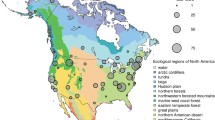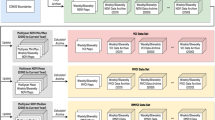Abstract
A Method is proposed for detecting vegetation change using global area coverage data from the NOAA-7 Advanced Very High Resolution Radiometer. Other methods of vegetation change detection, such as baseline images, are discussed, but not demonstrated. Vegetation Change Detection Images are produced by combining three separate weekly composites of Channel 2 minus Channel 1 AVHRR data. This compositing method takes the highest value of the differenced data for each week period and each pixel location. Three such weekly composites red imaged by individual red, green and blue CRT color guns respectively and then combined to form a color composite. The Vegetation Change Detection Image has 20 km resolution. It can be used to show an entire continent on a single image when the data point to CRT pixel ratio is 1:1. The vector vegetation change (magnitude and direction) is depicted by the color pattern resulting from the relative amount of red, green and blue placed in the pixel due to the individual weekly color composites. If there is no greenness change at a pixel location the amount of red, green and blue will be the same and a gray scale color results. The VCDI could provide a timely “first alert” for identifying regional and global agricultural changes.
Similar content being viewed by others
References
Eyton, R. J.: Landsat Multitemporal Color Composites. Photogrammetic Engineering and Remote Sensing 49, 2, 231–235. (Feb. 1983)
Gray, T. I.; Helfert, M R; McCrary, D. G.: Artificial Satellites, An Information Source for the Earth's Arable Lands and Hydrosphere. in press.
Gray, T. I.; McCrary, D. G.: Meteorological Stallite Data-A Tool to Describe the Health of the World's Agriculture, 12 p. AgRISTARS Report EW N1-04042, Houston, TX, February 1981a.
Gray, T. I.; McCrary, D G.: The Environmental Vegetative Index-A Tool Potentially Useful for Arid Land Management. 5 p. Preprint Vol. of Extended Abstracts, 15th Conf. Agri. & Forest Meteorology and Fifth Conf. Biometeo, April 1–3, 1981, Anaheim, CA, AMS, Boston, MA, Reprinted as AgRISTARS Report EW N1-04076. Houston, TX 1981 b.
Helfert, M. R.; McCrary, D. G.; Gray, T. I.: Utilization of Meteorological Satellite Imagery for World-Wide Environmental Monitoring: The Lower Mississippi River Flood of 1979 — Case 1. 26 pp. Agristars Report EW-N1-04104, Houston, TX 1981.
Horvath, N. C.; Gray, T I.; McCrary, D. G.: Advanced Very High Resolution Radiometer (AVHRR) Data Evaluation for use in Monitoring Vegetation, Volume 1 — Channels 1 and 2. Proceedings — Auto Carto 5 — Environmental Assessment and Resource Management, August 22–28, 1982, pp. 347–356. American Society of Photogrammetry and American Congress on Surveying and Mapping, Falls Church, VA 1982.
McCrary, D. G.; Helfert, M. R.; Gray, T. I.; Conte, D.: An Evaluation of the NOAA Polar-Orbiter as a Tool for Mapping Freeze Damage in Florida during January 1982. Proceedings — Auto Carto 5 — Environmental Assessment and Resource Management, August 22–28, 1982, pp. 715–722. American Society of Photogrammetry and American Congress on Surveying and Mapping, Falls Church, VA 1982.
Norwine, J.; Greegor, D. H.: Vegetation Classification Based on Advanced Very High Resolution Radiometer (AVHRR) Satellite Imagery. Remote Sensing on the Environment 13, 69–87 (1983)
Schneider, S.; McGinnis, D. Jr.: Spectral Differences Between VHRR and VISSR Data and Their Impact on Environmental Studies. Proceedings of the American Society of Photogrammetry, 43 Annual Meeting, Feb. 27–March 5, 1977, Washington, 1977.
Wickware, G. M.; Howarth, P. J.: Change Detection in the Peace-Athabasca Delta Using Digital Landsat Data. Remote Sensing of the Environment 11, 9–25 (1981)
Author information
Authors and Affiliations
Additional information
Doubts have been expressed about the reliability of this satellite data because of the unknown (and variable) effects of atmospheric attenuation. A basic qualitative rather than quantitative analysis of the data has been suggested as the correct approach.
Rights and permissions
About this article
Cite this article
Nerem, R.S., Holz, R.K., Helfert, M.R. et al. Vegetation change detection from NOAA polar orbiting satellites. GeoJournal 11, 313–320 (1985). https://doi.org/10.1007/BF00150766
Issue Date:
DOI: https://doi.org/10.1007/BF00150766




